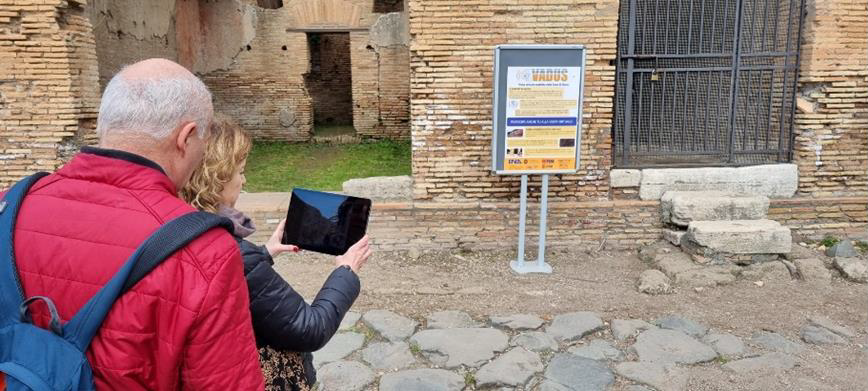Italy boasts some of the most beautiful ancient artefacts in the world but managing open access to these unique heritage sites while preserving their integrity is an ongoing challenge. The VADUS (Virtual Access and Digitisation for Unreachable Sites) project, led by Italian strategic technology company NEXT Ingegneria dei Sistemi and supported by ESA’s Business Applications and Space Solutions (BASS) programme within the 5G/6G Strategic Programme Line, combines new 5G technologies, Galileo High Accuracy Service (HAS) and Augmented and Virtual Reality (AR/VR) technologies to address these challenges.
VADUS uses 3D colour scanning and laser-induced fluorescence (LIF) which allows them to capture high-resolution 3D models. These models are used to create virtual environments which can then be explored via mobile apps or wearable VR devices. However, seamless AV/VR experiences are only possible thanks to 5G technologies and HAS satellite services.
At a time when local economies can subsist on tourism for income but must balance the impact from tourists, AR/VR technologies offer a solution. There may also be historical locations or information not open to the public due to their fragility or lack of accessibility. In these cases, AR/VR can enrich the cultural experience at museums, archaeologic sites, and other heritage monuments by providing access to these sites.
Despite the potential for these media technologies to make sites accessible and provide tourists with new experiences, certain technical requirements such as bandwidth or connection limitations limit the scope of these applications. Previously, AR/VR experiences were limited to a static position due to the technological restraints of mobile devices or VR headsets. In many cases, this led to an underwhelming or poor experience for the user. However, the VADUS application allows users a tailored AR/VR experience where the can move freely around the virtual world.
“VADUS will act as a technological enabler, to overcome the difficulties related to access for environmental reasons, like the preservation of the asset, due to architectural barriers or related to the 'fruition' of a cultural asset” says Valeria Spizzichino, an ENEA researcher at the Diagnostics and Metrology Laboratory.
The VADUS team demonstrated the app’s potential at four historical sites in Italy: Casa di Diana (House of Diana), Fortezza del Pastiss (Pastiss Fortress), Aula Isiaca (Isiac Hall) and Casa dei Grifi (House of Griffins). Not only were users able to traverse the virtual world freely via 5G tablets at many of the demonstration sites, additional media and insights were provided thanks to LIF, which allowed artefacts which have been damaged or destroyed to be reconstructed virtually.
“I am extremely pleased with the final results of the VADUS project” says Davide Coppola, Head of ESA’s Space Applications Initiatives Section. “ESA’s support in this endeavour will not only allow the public virtual access to previously unseen sites but bring awareness and preserve important cultural heritage sites in Italy and beyond.“
VADUS is looking to build on the successful trials in Italy and provide tailored apps, tours, and experiences to museums, cultural institutions, local communities, and archaeological parks in the future.



